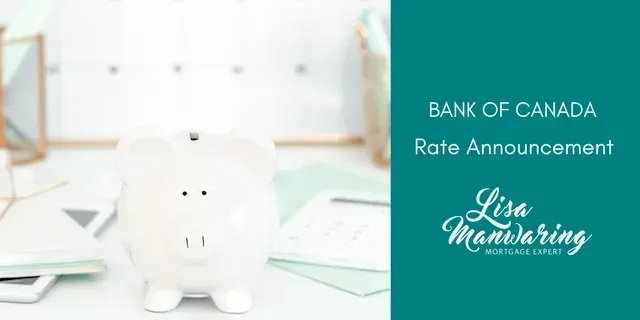Protecting Your Credit Score Through COVID-19
Lisa Manwaring • March 31, 2020

Personal finance is undoubtedly on the minds of most Canadians. For a lot of us, incomes have been reduced, but living expenses remain the same.
The full economic impact of the COVID-19 Pandemic is still uncertain. Unemployment is skyrocketing, people are social distancing, self-isolating, and businesses are struggling to stay afloat. At the writing of this article, over 1 million Canadians have already applied for EI.
However, the federal government has just announced several new programs designed to help those individuals, families, and businesses whose employment has been impacted by COVID-19. If you meet the qualifications for assistance, you should apply.
Now, if you're looking to make sure your credit score isn't hurt during these times, here is some basic advice. The key to managing your credit is to stay on top of your payments. If possible, always make at least the minimum payment on your credit cards and line of credits.
Keep making payments on your instalment loans, car payments and the payments on your mortgage.
If you find yourself getting behind, this isn’t the time to put your head in the sand, instead, make contact with your lenders. Everyone is going through tough times, lenders understand this and have programs in place to help. Chances are, they will be able to reduce your payments, defer your payments, or even consolidate your debts.
Missing payments without communicating with your lender is not an acceptable way to defer payments. This won’t be looked upon favourably and your credit will be damaged as a result.
So, at this very moment, if you’re behind on any of your payments, and you have the means to pay, right now would be a good time to go and make at least the minimum payment. Or to contact your lender and make payment arrangements, communication is everything.
Mortgage lenders have announced their contribution to easing financial stress is to offer mortgage payment deferrals for up to six months. And although this will be an excellent option for some to provide immediate financial relief, it might come with some unforeseen challenges down the line, credit misreporting being one of them.
The truth is, you won’t be penalized for restructuring or deferring your mortgage payments. Still, if your lender’s system isn't correctly adjusted, there’s a good chance something will misreport to the credit agencies and this could lower your credit score. This is true of credit cards, loans, car payments, and mortgage payments.
So, if you do find yourself having to make special arrangements with your lender or you want to defer your mortgage payments, here is a list of things you should consider doing:
- Request written confirmation (email is fine) of the new terms. Get everything in writing. Although it’s probably easiest to call into your bank, things get missed in conversations, having everything in writing is best for you!
- Make sure you record who you have been talking with, along with the date and time of any conversations. Keep minutes for yourself.
- Track your credit score on Equifax and Transunion after the new arrangements are in place.
- If you see any discrepancies, contact your lender immediately, and open a dispute with the credit reporting agencies.
Do your best to keep on top of your payments, make arrangements if you can’t. In time, this will pass. If you’d like to discuss mortgage options, please don’t hesitate to contact me anytime. We’re all in this together!
RECENT POSTS

Bank of Canada maintains policy rate at 2.1/4%. FOR IMMEDIATE RELEASE Media Relations Ottawa, Ontario December 10, 2025 The Bank of Canada today held its target for the overnight rate at 2.25%, with the Bank Rate at 2.5% and the deposit rate at 2.20%. Major economies around the world continue to show resilience to US trade protectionism, but uncertainty is still high. In the United States, economic growth is being supported by strong consumption and a surge in AI investment. The US government shutdown caused volatility in quarterly growth and delayed the release of some key economic data. Tariffs are causing some upward pressure on US inflation. In the euro area, economic growth has been stronger than expected, with the services sector showing particular resilience. In China, soft domestic demand, including more weakness in the housing market, is weighing on growth. Global financial conditions, oil prices, and the Canadian dollar are all roughly unchanged since the Bank’s October Monetary Policy Report (MPR). Canada’s economy grew by a surprisingly strong 2.6% in the third quarter, even as final domestic demand was flat. The increase in GDP largely reflected volatility in trade. The Bank expects final domestic demand will grow in the fourth quarter, but with an anticipated decline in net exports, GDP will likely be weak. Growth is forecast to pick up in 2026, although uncertainty remains high and large swings in trade may continue to cause quarterly volatility. Canada’s labour market is showing some signs of improvement. Employment has shown solid gains in the past three months and the unemployment rate declined to 6.5% in November. Nevertheless, job markets in trade-sensitive sectors remain weak and economy-wide hiring intentions continue to be subdued. CPI inflation slowed to 2.2% in October, as gasoline prices fell and food prices rose more slowly. CPI inflation has been close to the 2% target for more than a year, while measures of core inflation remain in the range of 2½% to 3%. The Bank assesses that underlying inflation is still around 2½%. In the near term, CPI inflation is likely to be higher due to the effects of last year’s GST/HST holiday on the prices of some goods and services. Looking through this choppiness, the Bank expects ongoing economic slack to roughly offset cost pressures associated with the reconfiguration of trade, keeping CPI inflation close to the 2% target. If inflation and economic activity evolve broadly in line with the October projection, Governing Council sees the current policy rate at about the right level to keep inflation close to 2% while helping the economy through this period of structural adjustment. Uncertainty remains elevated. If the outlook changes, we are prepared to respond. The Bank is focused on ensuring that Canadians continue to have confidence in price stability through this period of global upheaval. Information note The next scheduled date for announcing the overnight rate target is January 28, 2026. The Bank’s next MPR will be released at the same time.

What Is a Second Mortgage, Really? (It’s Not What Most People Think) If you’ve heard the term “second mortgage” and assumed it refers to the next mortgage you take out after your first one ends, you’re not alone. It’s a common misconception—but the reality is a bit different. A second mortgage isn’t about the order of mortgages over time. It’s actually about the number of loans secured against a single property —at the same time. So, What Exactly Is a Second Mortgage? When you first buy a home, your mortgage is registered on the property in first position . This simply means your lender has the primary legal claim to your property if you ever sell it or default. A second mortgage is another loan that’s added on top of your existing mortgage. It’s registered in second position , meaning the lender only gets paid out after the first mortgage is settled. If you sell your home, any proceeds go toward paying off the first mortgage first, then the second one, and any remaining equity is yours. It’s important to note: You still keep your original mortgage and keep making payments on it —the second mortgage is an entirely separate agreement layered on top. Why Would Anyone Take Out a Second Mortgage? There are a few good reasons homeowners choose this route: You want to tap into your home equity without refinancing your existing mortgage. Your current mortgage has great terms (like a low interest rate), and breaking it would trigger hefty penalties. You need access to funds quickly , and a second mortgage is faster and more flexible than refinancing. One common use? Debt consolidation . If you’re juggling high-interest credit card or personal loan debt, a second mortgage can help reduce your overall interest costs and improve monthly cash flow. Is a Second Mortgage Right for You? A second mortgage can be a smart solution in the right situation—but it’s not always the best move. It depends on your current mortgage terms, your equity, and your financial goals. If you’re curious about how a second mortgage could work for your situation—or if you’re considering your options to improve cash flow or access equity—let’s talk. I’d be happy to walk you through it and help you explore the right path forward. Reach out anytime—we’ll figure it out together.


